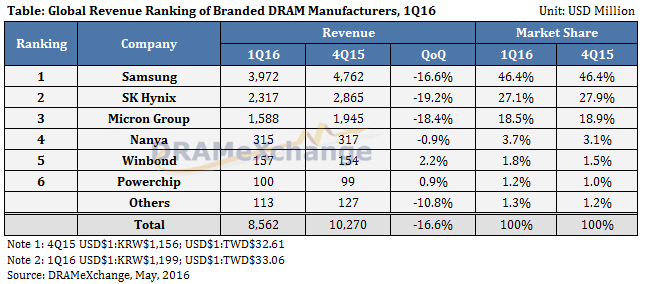Price Check Q3 2016: DRAM Prices Down Over 20% Since Early 2016
by Anton Shilov on July 25, 2016 12:01 AM ESTSamsung Retains Market Leadership
According to DRAMeXchange, the global DRAM industry earned $8.56 billion revenue in Q1 2016, down from $12.1 billion in Q1 2015 (-29.3%) and from $10.27 billion in the fourth quarter of last year (-16.6%). Analysts have stated that the dropping prices for DRAM ICs and relatively low demand for computer memory as primary reasons for the revenue declines.
With a nearly 30% year-over-year decrease, it is not surprising that all DRAM manufacturers suffered from declining revenue and dropping margins, even though the industry stayed profitable as a whole in the first quarter.
Samsung remained the world’s largest supplier of DRAM in the first quarter with 46.4% of the market (up from 43.1% in Q1 2015), not challenged by its key rivals. Meanwhile, SK Hynix commanded 27.1% of DRAM shipments in the first quarter of 2016, slightly down from the previous quarters. The third largest DRAM maker, Micron, controlled 18.5% of the planet’s DRAM sales in Q1 2016, a significant decrease from 22.5% in the same period a year before.
But Smaller Vendors Pick Up Pace
By contrast, smaller makers like Nanya, Winbond, PowerChip and some other managed to increase their shares slightly in the first quarter of this year. The analysts believe that this happened because they increased their output and could simply supply more DRAM than usual.
Wrapping everything up, it is evident that the transition to DDR4 memory is proceeding rapidly and the industry will produce more DDR4 bits than DDR3 bits later this year. As a result, DDR4 should trend towards being cheaper than DDR3 when the amount of DDR4 will significantly outpace the older technology. It is also noteworthy that Samsung will be able to greatly benefit from its 18 nm fabrication technology in the second half of this year, as its rival Micron is not expected to be ready with its 16 nm manufacturing process before Q4. Thus, Samsung may be able to sell its high-performance and/or low-power DRAM ICs at a premium.











37 Comments
View All Comments
Ratman6161 - Monday, July 25, 2016 - link
Ummm. I think you may have your decimal points in the wrong position? i.e. $1.751 should be $17.51? Looking on NewEgg I don't see a single 4 GB modual for a dollar seventy five :)bananaforscale - Monday, July 25, 2016 - link
Those are chip prices, not module prices, and it's 4 Gb, not GB. Put 8 of those on a DIMM and you're in the ballpark.Ratman6161 - Monday, July 25, 2016 - link
Ahhh. My mistake. I generally don't bother thinking about the cost of components within the components - just the actual module I'm buying.:)andychow - Monday, July 25, 2016 - link
Wouldn't that be defined as illegal collusion?
FunBunny2 - Monday, July 25, 2016 - link
-- Wouldn't that be defined as illegal collusion?this is the USofA. everything in law has to be "business friendly".
DanNeely - Monday, July 25, 2016 - link
Only if they meet privately and do it in secret. Public statements on the line of "a pricewar from flooding the market and driving sale costs below production costs would only screw everyone; we're not going to start one" are fine.poohbear - Monday, July 25, 2016 - link
This is a cyclical industry, and DRAM prices have bottomed out. They've already started the upwards trend in pricing, next year they should be considerably more expensive, so buy now if you plan on upgrading within the next year before prices go up!